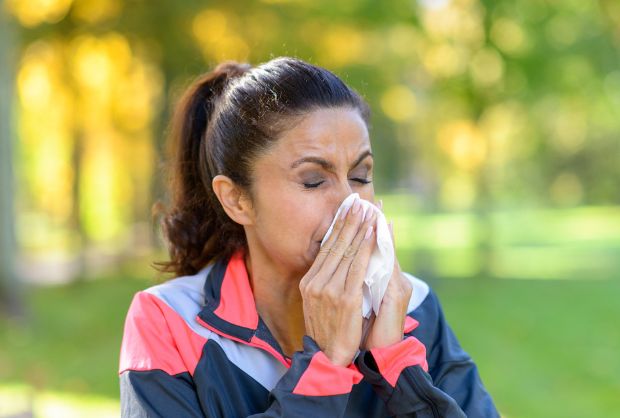
Embarking on a workout routine whilst battling an illness can lead to a crossroads of sorts, with many fitness enthusiasts grappling with the question: to exercise or not to exercise? This common conundrum touches on concerns such as exacerbating symptoms and the potential delay of recovery. However, it’s also balanced against the worry of losing momentum in a well-established fitness routine. While moderate physical activity is widely acclaimed for bolstering the immune system, it is crucial for individuals to heed their body’s signals and discern when pausing to recuperate is more beneficial than pushing through. This post aims to delve into the nuances of exercising when under the weather, providing insights into how to gauge your body’s readiness and the implications of working out while sick.
When It’s Okay to Exercise
You may have heard of the ‘above the neck’ rule, which suggests that if your symptoms are limited to the head, such as a runny nose or sore throat, it may be safe to engage in mild physical activity. This can include activities like walking or a gentle jog. In fact, some studies even suggest that light to moderate exercise during a common cold can boost your immune response, potentially helping you recover faster. However, it’s important to note that intense exercise sessions should be avoided, as they could further tax your body and potentially prolong your recovery. It’s always best to listen to your body and consult with a healthcare professional if you’re unsure about engaging in physical activity while experiencing cold symptoms.
When to Skip the Workout
However, it is important to pay attention to more severe or ‘below the neck’ symptoms such as a persistent and harsh cough, heavy chest congestion, upset stomach, or high fever. These symptoms should not be taken lightly, as they indicate that your body is waving a red flag of distress. In such cases, prioritising rest becomes paramount, as engaging in exercise could potentially worsen your condition or prolong the duration of your illness. It is especially crucial to note that a fever can significantly increase the risk of dehydration and adversely affect your heart rate, making any form of physical activity potentially dangerous. Therefore, it is crucial to listen to your body and seek appropriate medical advice when experiencing these symptoms.
Understanding the Impact on Performance
Even a mild illness, such as a common cold or flu, can significantly impact your usual performance levels. It’s crucial to listen to your body and sync with its demand for rest and recovery, as this is a vital step towards healing.
Pushing yourself beyond your current capacity during illness can not only delay your recovery but also decrease the overall benefits of your workout. It’s advisable to consider scaling back your exercise routine, which may entail reducing the weight, lowering the intensity, or shortening the duration of your workouts until you’ve fully bounced back to your optimal health.
By giving yourself the time and space to recuperate properly, you’re allowing your body to heal and regain the strength it needs to perform at its best once again. Remember, self-care and patience are key when it comes to maintaining a healthy and sustainable fitness routine, especially during times of illness or physical setbacks.
Safe Exercises When Feeling Under the Weather
When feeling under the weather, it’s important to listen to your body and adjust your exercise routine accordingly. If you’re experiencing minor symptoms, consider engaging in low-impact activities that can help maintain your mobility without overexerting yourself. Here are a few safe exercises to try:
- Walking: A gentle stroll can help get your blood flowing and improve circulation, while being easy on your body.
- Stretching: Gentle stretching exercises can help improve flexibility and relieve muscle tension, promoting relaxation and recovery.
- Yoga: Practicing yoga can help enhance both physical and mental wellbeing. Choose gentle yoga poses that focus on stretching and mindfulness.
- Tai Chi: This ancient martial art is known for its slow, deliberate movements and can be a soothing way to keep the body active and reduce stress without overtaxing the immune system.
- Pilates: Engaging in a gentle Pilates routine can help maintain core strength and improve overall stability, focusing on controlled movements to prevent any strain.
- Aquatic Exercises: Water-based activities, such as swimming or water aerobics, can be beneficial due to the buoyancy of water, which reduces impact on the joints while still providing resistance for muscle strengthening.
Remember, the key is to listen to your body and tailor your workout routine accordingly. If you start feeling worse during exercise or experience any concerning symptoms, stop immediately and seek appropriate medical advice. Listen to your body and prioritise rest when needed.
The Role of Hydration and Nutrition
When you’re feeling under the weather, your body needs extra fluids and nutrients to combat infection and support your immune system. Here are some tips to help you nourish your body and boost your immune system through diet:
- Stay well-hydrated: Drink plenty of water, herbal teas, and clear broths to keep your body hydrated and help flush out toxins.
- Load up on fruits and vegetables: Incorporate a variety of colourful fruits and vegetables into your meals and snacks. They are packed with essential vitamins, minerals, and antioxidants that can bolster your immune system.
- Include immune-boosting foods: Incorporate foods rich in vitamin C, such as citrus fruits, strawberries, bell peppers, and leafy greens. Additionally, consider adding garlic, ginger, turmeric, and other immune-boosting spices to your dishes.
- Don’t forget about protein: Include lean sources of protein, such as chicken, fish, beans, and lentils, to support immune function and promote healing.
- Get your dose of healthy fats: Incorporate sources of healthy fats, such as avocados, nuts, and seeds, to provide your body with essential nutrients and support overall immune health.
- Consider probiotics: Include probiotic-rich foods like yogurt, kefir, sauerkraut, and kimchi to promote a healthy gut microbiome, which plays a crucial role in immune function.
- Limit processed foods and added sugars: While it’s important to nourish your body, try to avoid or minimise processed foods and added sugars. These can weaken your immune system and hinder your recovery.
Remember, nourishing your body with a balanced and nutrient-rich diet can help support your immune system and aid in your recovery.
Returning to Your Routine Post-Illness
Resuming your regular workout routine after an illness requires a cautious and gradual approach to prevent any setbacks in your recovery. Here are several guidelines for safely getting back into exercise:
- Start Slowly: Begin with low-intensity workouts and gradually increase the intensity and duration. This might mean taking brisk walks or light jogs before returning to running or lifting lighter weights before attempting your previous loads.
- Monitor Your Body’s Response: Pay attention to how your body feels during and after exercise. Mild fatigue is normal, but if you experience pronounced tiredness, dizziness, or shortness of breath, take it as a sign to reduce the intensity of your workouts.
- Prioritise Rest: Ensure you have adequate rest between exercise sessions. Your body is still recovering, so adequate sleep and relaxation will support your immune system and repair processes.
- Hydrate and Nourish: Continuing to hydrate adequately and consume a balanced diet will support your return to fitness. Your body may require additional nutrients to rebuild and strengthen.
- Listen to Your Body: Look for signs that your body is ready for normal training intensity, such as feeling energised rather than fatigued after a workout, having the ability to perform workouts without abnormal discomfort, and the absence of illness symptoms.
- Consult a Professional: If you’re uncertain about how to proceed, consider consulting a fitness professional or your doctor to get tailored advice that considers your specific circumstances.
Remember, every individual recovers differently, and there is no one-size-fits-all approach. It’s important to recognise and respect your body’s signals and to avoid rushing the process, allowing yourself to return to pre-illness fitness levels naturally and safely.
Expert Advice
Professionals in the health field generally advise caution when it comes to exercising while sick. Their consensus is clear – if in doubt, sit it out. It’s particularly important to seek medical advice if your symptoms are severe, persistent, or if you have underlying health conditions that may be exacerbated by physical activity. By consulting with a doctor or a fitness expert who is well-versed in handling health-related exercise concerns, you can receive personalised advice tailored to your specific fitness goals and training schedules. This way, you can ensure that any exercise recommendations align perfectly with your individual needs and circumstances, promoting both your overall wellbeing and your progress towards achieving your desired fitness outcomes.
Conclusion
Listening to your body and properly assessing your symptoms can help you navigate whether exercise is beneficial or potentially harmful when you’re sick. The key takeaway is moderation and caution. While maintaining some level of activity with mild symptoms might be fine, it’s prudent to err on the side of rest when experiencing more serious symptoms. Ultimately, a balanced approach to fitness and health, which acknowledges the body’s signals, is the healthiest path to follow.
Striking the right balance between staying active and allowing your body to heal is not just smart; it’s a long-term investment in your fitness journey. Always remember to consult a healthcare professional if you’re unsure about exercising when sick. Now, as you recover, you can look forward to returning to your routine, energised and ready to go!

